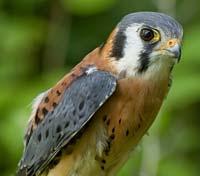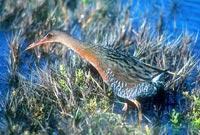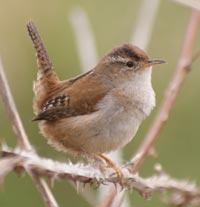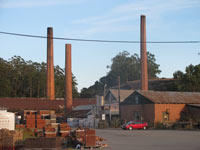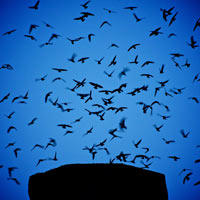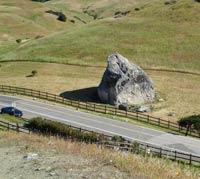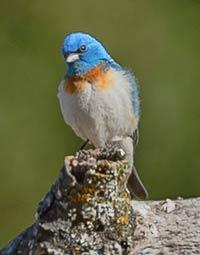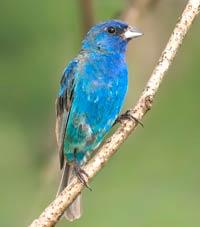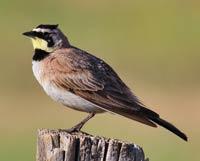Local Birding Sites: San Rafael
Las Gallinas
China Camp
Big Rock Ridge
Santa Margarita Island
Vaux's Swifts at McNear's Brickyard (September–early October)
Loma Alta (late spring)
As a special treat, you might see river otters swimming in the ponds. Look for the tracks they've made as they cross from one pond to the next. Continue past the ponds on the levee trail along the salt marsh and you’ll be rewarded with fine views of San Pablo Bay and looming Mount Diablo. Watch for an Osprey flying by with a fish in its talons, or scan the distant towers for one. In the fall and winter flocks of Western Meadowlarks grace the fields, easily identifiable with their stocky bodies, bright yellow breasts, and white outer tail feathers, and American Kestrels hover over the grasslands looking for small prey items. If you’re there late in the day you might hear a chorus of Clapper Rails sounding their loud kek-kek-kek calls across the marsh.
Marin Audubon Society sponsors a monthly walk that's great for beginner birders at Las Gallinas, on the first Thursday of each month from 9 am until noon.
To reach the Las Gallinas ponds, exit Hwy 101 at Smith Ranch Rd./Lucas Valley and drive east toward San Pablo Bay. Just before the entrance to McInnis Park, cross the railroad tracks and turn left. Follow this road .7 miles until it ends in a gravel parking lot.
- Go to the index of San Rafael birding sites or our Birding Sites Homepage -
China Camp State Park- Don Kimball Tucked out of the way of bustling urban areas on the shores of San Pablo Bay, China Camp is an underutilized gem when it comes to birding. Not only is the scenery absolutely stunning with picturesque artistic views of quiet waters and peacefully adrift sailboats, there are plenty of opportunities to study birds here as well. When it comes to birding it’s all about habitat and China Camp presents a rich variety. There are more than 100 acres of tidal area alone consisting primarily of saltwater marsh. Native grassland is also present and as one moves away from the water’s edge the flora changes dramatically. Large Black Oak dot the marshy meadows while Live Oak dominate the dry uplands. Blended throughout the live oak forest are abundant Madrone and Bay trees, while chaparral and Manzanita dominate many of the more open areas and forest edge. One can spend hours birding the water’s edge throughout the park and there are many good locations to stop, park, and bird. A spotting scope is a great tool for close up views of water birds and winter months at China Camp can be especially great birding. Western and Clarke’s Grebes make their presence known with characteristic calls while rafts of Scaup, Canvasback, and Ruddy Ducks appear regularly. Waders like Great and Snowy Egrets with their snow white plumages stalk the waters for small prey, while Killdeer and other shorebirds work the muddy areas at low tide. California Quail and more recently Wild Turkey can be easily been seen while raptors such as White-tailed Kites and Red-shouldered Hawks soar effortlessly over the park’s open areas. The park is an important breeding area for the uncommon Black Rail and a great place to view five different species of swallows. Songbirds are present here as well. During the spring Orange-crowned Warblers trill from the chaparral while the ubiquitous Wrentit also makes its presence known with its staccato bouncing ball type song. Ravens breed within the park’s boundaries and at least one pair of Pileated Woodpeckers nest here. With summer in full swing, Blue-gray Gnatcatchers hunt for insects in the forest canopy while Ash-throated Flycatchers announce their whereabouts from the dry woodlands with their classic Ka-brick calls. Look for Anna’s Hummingbirds throughout the park any time of the year, while Allen’s and Rufous appear seasonally. Western Bluebirds and California Towhees are common breeders as are Lesser Goldfinches. As the summer evenings wind down, Spotted Towhees skulk in the underbrush giving their nasal calls as the night birds begin to stir. Soon Great Horned Owls dominate the air with their classic hoot owl calls while it seems almost every stand of oaks has its own resident pair of Western Screech Owls. This is only a brief overview of the many species to be studied within China Camp’s boundaries. Getting to China Camp is easily done by leaving Highway 101 and traveling East on North San Pedro Road for about 3 miles. Weekend usage can be often quite heavy especially when it comes to mountain bike use on the main trails. However weekdays are a much different story. One can often have the trail to yourself and many of the trails are serene and quiet except for the sound of birds. Most are surprised that such a beautiful park with such great birding is right on our own doorstep! |
|
|
|
|
|
|
|
|
|
- Go to the index of San Rafael birding sites or our Birding Sites Homepage -
Fall on Big Rock Ridge- Jack Gedney, September 2017 Big Rock Ridge is the dominant topographical feature of Northeast Marin, dividing Novato’s Ignacio Valley from San Rafael’s Lucas Valley. At 1,895 ft, its highest hill is the second highest point in Marin. Step outside the doors of our store and you’ll see its familiar towers. Or stay inside, buy some birdseed, and look at the mural behind the register—they’re on there too. High ridges like these certainly have their scenic value, but they offer more gifts to those who climb: 360-degree views, breathing room above the lowland hubbub, and opportunities to witness bird migration as it happens. Parts of Big Rock Ridge are included in the neighboring Lucas Valley, Ignacio Valley, Loma Verde, and Pacheco Valley Marin County Open Space Preserves, as well as land owned by Marinwood Open Space and private land with easements granted for public access on trails. There’s a lot of area! In fact, the trail continue to the south over Loma Alta and through a network of public lands all the way to the Golden Gate on the Bay Area Ridge Trail network. Currently, the northern extent of continuous Ridge Trail is reached near the top of Big Rock Ridge, with a gap then existing before the trail resumes in Novato’s Indian Tree Open Space Preserve (really still part of Big Rock Ridge—check it out on Google Earth, it’s fun) and continues up and over Mount Burdell on its way to Sonoma. For our current purposes, we’re discussing the main fire road that runs roughly west-to-east along the top of the ridge, accessible from various points both to north and south. Almost all of these trails which climb the sides of the ridge are steep, as is the trail along the ridgeline as it ascends and descends each of several successive peaks. It is difficult to construct any loops along the ridge, so your options are either an out-and-back from any of the various trailheads or a point-to-point hike if you can arrange a drop-off or car shuttle of some kind. That’s fun. The natural starting point is from the Big Rock on Lucas Valley Road about 5.5 miles west of Highway 101. This obvious landmark marks the trailhead that ascends the western end of the publically accessible ridge, near the summit, though this trail is largely well-graded with moderate switchbacks compared to the steep ups and downs you will find along the ridgeline itself. Let’s get to the birds. From the Lucas Valley/Big Rock trailhead, you will find yourself in grassland dotted with coyote bush on the lower and gentler southern slopes of the ridge. (Directly across the road is the Loma Alta Fire Road heading south, which we’ve described elsewhere.) These grasslands provide good habitat for American kestrels, small, swift, and colorful falcons which you may see pause and hover in the air as they search for small rodents. In summer, a variety of swallow species will take the lead in aerial insect-catching duty, including cliff, barn, and tree swallows. Flycatching western bluebirds are joined in winter by Say’s phoebes along fence lines or whatever natural perches are available in this relatively open habitat. The patches of coyote bush provide cover in fall for the arriving white-crowned and golden-crowned sparrows, whose songs are a highlight of the generally quieter October soundtrack. As you climb past groves of live oaks, take your time to look for more songbirds. Year-round resident chestnut-backed chickadees, oak titmice, and Bewick’s wrens are joined in fall by yellow-rumped warblers, Townsend’s warblers, and subtle ruby-crowned kinglets. The oaks provide an abundance of food, from the thin and pointy acorns which mature in fall, to the many insect species which find a home in their foliage. You may hear the resounding echo of a northern flicker before seeing the bursts of its distinctive red-shafted wings as it flies to a new perch , or a flutter of wings as a dozen Band-tailed Pigeons take flight from an oak to wheel in a swift circle or two before resettling in another tree. Both of these birds are year-round residents in Marin whose numbers swell in winter with the arrival of migrants from more northerly areas. More densely wooded patches near creek beds host both loud and striking Steller’s jays and quiet and discrete hermit thrushes, another bird that, while present year-round in the county, disperses to a greater variety of habitats in winter. Fall Migration As you approach the ridgeline, migration becomes an observable phenomenon. Small squadrons of Mexico-bound violet-green swallows and related species course southeast above the ridge, occasionally turning in small, swooping circles to catch an insect or recalibrate their position in the group. Our other speedy and indefatigable flyers, the swifts, also pass through in fall, both Vaux’s swifts and white-throated swifts. (Visit McNear’s Brickyard in San Rafael in late September to see thousands of Vaux’s swifts entered the unused chimneys at sunset for their nightly rest.) Fall is also the season for hawk migration: you’ll see some birds heading more or less determinedly south, while many other raptors will be seen hunting on the wing. Red-tailed hawks, kestrels, and Cooper’s hawks can be seen all year-round, but both abundance and variety increases in fall with the arrival of sharp-shinned hawks, northern harriers, and merlins on migration. Beyond the Peak |
Towers on Big Rock Ridge, as symbolically represented on our mural by Faith Rumm. |
|
American Kestrel - Photo by Greg Hume |
|
|
Townsend's Warbler - Photo by Linda Tanner |
|
|
Violet-green Swallow - Photo by Cory Gregory |
To reach the trailhead by the Big Rock, travel west around 5.5 miles on Lucas Valley Rd. There is a large pullout on the left across from the Big Rock, with an opportunity to turn around shortly afterwards if needed. Note that there is about 1250’ of elevation gain to the high point of the ridge, much of it unshaded, as well as continued fairly strenuous hiking along the ridgeline. For a map and alternate paths up Big Rock Ridge, visit Marin Open Space.
- Go to the index of San Rafael birding sites or our Birding Sites Homepage -
Santa Margarita Island- Don Kimball, July 18, 2013 Nestled amid the subdivisions of Santa Venetia near San Rafael, Santa Margarita Island preserve is a tiny plot of land just under nine acres managed by the Marin Open Space District. With easy access off of N. San Pedro Rd. this is an ideal spot for folks with mobility issues or the beginning birder who simply wants a quick and easy stroll to enjoy the local birds. The small forest here contains three species of oak as well as madrones and California bay trees. Particularly noteworthy among plant species, the California pipevine grows here which in turn attracts the pipevine swallowtail butterfly. The arrival of spring on Santa Margarita brings with it flocks of migrating songbirds. Yellow-rumped warblers comb the new green oak flowers for protein rich insects while the last remaining Golden-crowned Sparrows search the base of shrubs for any available food. They will soon be departing for their northern breeding grounds. As spring progresses Barn Swallows nest under the bridge to the island while Tree and Violet-green Swallows patrol the air for insects. Common Crows nest amid the treed areas often sharing nesting sites with a pair of White-tailed Kites. The kites can be seen hovering over the marsh grasses searching for available prey. California Clapper Rails breed in the cattails and sedges surrounding the island and can be seen in almost any season. With luck one may even see them walking around on the mud once the tide has gone out. The best times to see the rails are generally at dusk or at dawn's breaking. A vigorous clapping of one's own hands can often prompt the rails to "clap" back. White Pelicans and geese are present during the summer, as well as resident California and Spotted Towhees and a host of other songbirds. Songbirds include Marsh Wrens, Nuttall's Woodpeckers, Oak Titmice, White-breasted Nuthatches, and Black Phoebes. As summer wanes migrating shorebirds begin to comb the mud flats surrounding this tiny island. Greater and Lesser Yellowlegs, Killdeer, and the ever present Black-necked Stilt to name just a few. With the onset of fall waterfowl begin to show in increasing numbers. With no hunting permitted here waterfowl find a reprieve in the muddy sheltered waterways that completely circle the island. By winter flocks of Redheads, Canvasback, Gadwall, and Northern Shovelers can be found and are easy to observe. They are often joined by the diving ducks, Buffleheads and scaup being the norm. A visit to Santa Margarita Island will leave you refreshed by the peaceful surroundings and you can never come away without adding to your knowledge of our local birds. For Santa Margarita location information and map, visit Marin Open Space. |
Pipevine Swallowtail |
|
Clapper Rail |
|
|
Marsh Wren. Photo by leetop on Flickr. |
- Go to the index of San Rafael birding sites or our Birding Sites Homepage -
Vaux's Swifts at McNear's Brickyard
- Jack Gedney, 9/17/15 For some people, looking at birds and wildlife means going where all the life is wild—to the undeveloped areas where natural plant communities are intact and human presence is at a minimum. But while observing birds within the full web of an age-old ecosystem is certainly a highly satisfying experience, limiting oneself to only pristine natural habitats goes against the general creed of the backyard birdwatcher: appreciate nature wherever you find it, the more convenient the better. To do otherwise risks missing out on the myriad ways in which birds and wildlife continue to exist within our admittedly much-changed landscape. One stunning example of this is the annual fall migration of Vaux’s swifts. Swifts are superficially similar to our familiar summer swallows in their typical habit of constant swift flight as they catch insects on the wing. With a streamlined boomerang or crescent shape (the aerodynamic compression of their body has led them to be likened to a “cigar with wings”), swifts spend essentially their whole day in flight. The main species in question locally, Vaux’s swifts (pronounced “Vawks”), historically roosted communally in large, hollow trees. With the limited availability of such trees along this stretch of their southward migration route from the Pacific Northwest to Central America, they now take advantage of similar manmade structures such as the unused chimneys at San Rafael’s McNear Brickyard off Point San Pedro Road. Each year, September and early October visitors to the brickyard can watch the migrating swifts pour into the smokestacks at sunset. The numbers can vary from night to night: sometimes you will see a few hundred, other nights you can see many thousands. Not uncommonly, raptors such as kestrels or peregrine falcons are drawn to the crowd of birds. Some other birds are also visible along the adjacent bayshore. But the main attraction is undoubtedly the swirling vortex of swifts. For more information and photos, visit this 2014 blog post from the Golden Gate Audubon Society. You can use the address of 1 McNear Brickyard Rd. in San Rafael for directions. Plan on arriving before sunset and please be respectful of the property owners. Commercial activity is ongoing during the day, but they have graciously welcomed birders in the evening. Limited parking is available along the roadside outside of the entrance gate. Some street parking is also available on Riviera Dr. and Lagoon Dr. across the street, and in a small lot on the left side of Chapel Cove Dr. immediately to the north along Point San Pedro Rd. |
McNear's Brickyard |
|
An atmospheric shot of Vaux's Swifts entering a Portland Chimney - Robert Britt |
|
|
Video from McNear's by Paul Kienitz. Double-click for full-screen. |
- Go to the index of San Rafael birding sites or our Birding Sites Homepage -
Loma Alta Fire Road in Spring
- Jack Gedney, 5/19/16
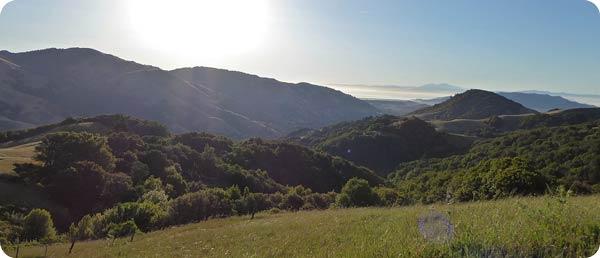
|
Loma Alta (“tall hill”) is one of the higher points in Marin, about the equal of Novato’s Mount Burdell at a bit under 1600’. It gives its name to a county open space preserve on its southern slopes in Fairfax. The peak itself, however, lies to the north of the official preserve boundaries, as does the 2.5 mile “Loma Alta Fire Road” which travels northward from the preserve on an easement over private land to Lucas Valley Road. And for us north Marin naturalists, this fire road is often what is conjured up by the words “Loma Alta”: a hotspot for late spring serpentine wildflowers and dry, rocky grasslands ideal for a number of birds that are uncommon in much of the county, such as lazuli buntings, horned larks, meadowlarks, lark sparrows, and grasshopper sparrows. And the views aren’t too bad either! The most convenient access to the main birding hotspots is from this northern trailhead on Lucas Valley Road, some five miles west from Highway 101, on the south side of the road across from the Big Rock. (We’ve written elsewhere about fall on Big Rock Ridge, experienced by traveling north from the same trailhead.) At the start, you might see cliff or violet-green swallows, black phoebes, or western bluebirds perched along the fenceline, the local red-tailed hawk perched upon the Big Rock, or a raven loudly flapping his way down the valley in the stiller morning air. If you make it out there before spring has totally elapsed, you will be treated to an impressive show of flowers along the trail, with prominent patches of brodiaea, yarrow, multiple lupine species, and much more. Nearly as important as your timing in the year is your timing in the day: early morning visits in spring will have more bird song, as well as potentially less wind for better listening and cooler temperatures for climbing up the largely unshaded hills. As you ascend past stands of trees dropping off into side canyons, you will likely hear more birds than you can see, from the loud ka-BRICKS of ash-throated flycatchers and the subtler upward whistles of pacific-slope flycatchers, to the more musical songs of warbling vireos, orange-crowned warblers, and Bewick’s wrens. You’ll also probably hear some other less seasonally restricted sounds, like the resounding calls of California quail, the harsh calls of scrub-jays and Steller’s jays, the loud croaks of spotted towhees, the gobbling of unseen turkeys, and the carrying nasal honks of white-breasted nuthatches. First stop: buntingsAfter perhaps half a mile or so, you may hear another song, not too distant from the trail, belonging to one of our more colorful summer birds, the lazuli bunting. Buntings often sing from fairly prominent perches in trees, so make sure to look over the trees for these blue, white, and red singers. From 2014-2017, this fire road has also hosted an uncommon indigo bunting, a closely related bird generally found in the eastern part of the country, but which makes sporadic and now increasingly frequent appearances in the Bay Area. A beautiful rich blue all over, this particular individual is partial to one of the larger groups of trees and coyote bush that occurs on both sides of the trail about a mile from the start. Flying between the live oaks and bays, the indigo bunting is also a vigorous singer that may use any of these trees to perch, but you can recognize the right group of trees by a large blue elderberry, many of whose large heads of small creamy flowers are still closed and green as of mid-May. This patch of trees is also a good place to look for lazuli buntings, orange-crowned warblers, and Allen’s hummingbirds. Further upMany birders have been making the trip out to this point to see the indigo bunting, but don’t stop there! Although you may have seen a few of this area’s specialty birds already by this point, the larks and pseodo-larks become more abundant as you continue upward and leave most of the trees behind. Pseudo-larks? The most obvious is the western meadowlark, a plump member of the blackbird family that is brilliant yellow on the front and a camouflaging brown on the back. Loma Alta is one of the best places to hear their beautiful spring song as they perch on fence posts, utility poles, and rock outcroppings. The second not-a-real-lark is the lark sparrow, probably our most handsome sparrow, with an intricate pattern of multi-colored face stripes. And then we have our one true lark, the horned lark, the least common of these three birds in Marin and the one with the strongest preference for the higher grassland areas beyond the bunting trees. Once you make it to their preferred habitat, horned larks have a major nice habit from the observer’s standpoint: they prefer feeding on the dusty exposed trail rather than in among the grasses, making them easier to see and approach. Another specialty bird in this area is the grasshopper sparrow, whose convenient observability is about the opposite of the horned lark. They are more often heard than seen (with careful listening, you can pick up their “song” of two quick clicks and then an insect-like buzz), since they have little inclination to leave the ground where they remain largely invisible beneath the grasses. They aren’t particularly striking visually, a general brownish with subtle yellow face marks. You are, however, likely to see many Savannah sparrows, much streakier affairs (grasshoppers have unstreaked breasts) who also have yellow spots in front of their eyes. These sparrows, the horned larks, and the not-real-larks are best seen on the approach to and descent from the high point’s distant views. Travel a bit beyond for a little more of the same or to extend your walk--or reverse course at the summit, leaving time to revisit the bunting trees and lower flower patches before returning to the rock. |
The Big Rock on Lucas Valley |
|
Lazuli Bunting - local photo by Larry Scheibel |
|
|
Indigo Bunting - Kelly Colgan Azar |
|
|
Horned Lark - Tom Benson |
- Go to the index of San Rafael birding sites or our Birding Sites Homepage -


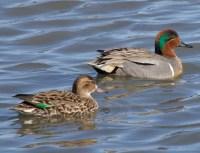
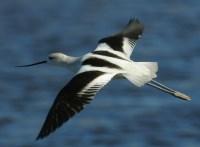
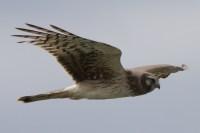 Northern Harrier
Northern Harrier
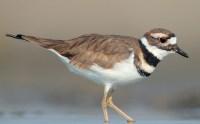 Killdeer
Killdeer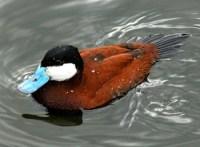 Ruddy Duck
Ruddy Duck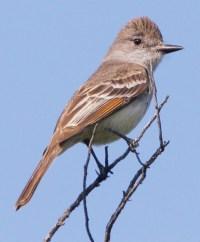 Ash-throated Flycatcher
Ash-throated Flycatcher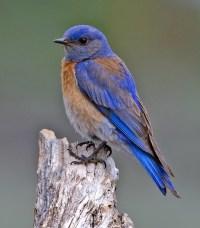 Western Bluebird by Alan D. Wilson
Western Bluebird by Alan D. Wilson
